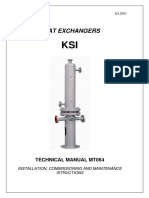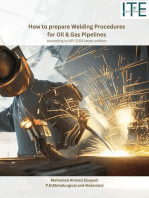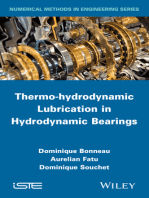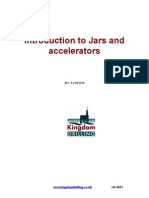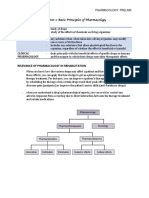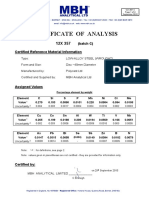Professional Documents
Culture Documents
Operating and Maintenance Norms For Cylinders and Servocylinders
Operating and Maintenance Norms For Cylinders and Servocylinders
Uploaded by
rrogerr_07Original Description:
Original Title
Copyright
Available Formats
Share this document
Did you find this document useful?
Is this content inappropriate?
Report this DocumentCopyright:
Available Formats
Operating and Maintenance Norms For Cylinders and Servocylinders
Operating and Maintenance Norms For Cylinders and Servocylinders
Uploaded by
rrogerr_07Copyright:
Available Formats
These operating and maintenance norms are valid only for Atos hydraulic cylinders and are intended
to provide useful information and
to avoid risks when hydraulic cylinders are installed in a machine or a system. Information and notes on the transport and storage of
hydraulic cylinders are also provided.
These norms must be strictly observed to avoid damages and ensure trouble-free operation. The respect of these operating and main-
tenance norms ensures an increased working life and thus reduced repairing cost of the hydraulic cylinders and system.
B600
Index
SYMBOL CONVENTIONS
GENERAL NOTES
HARMONIZED STANDARDS
WORKING CONDITIONS
NAMEPLATES
CE MARKING
ATEX CERTIFICATION
SAFETY NOTES
MAINTENANCE
TRANSPORT AND STORAGE
Operating and maintenance norms for cylinders and servocylinders
Table B600-1/E
www.atos.com
1 SYMBOLS CONVENTIONS
3 HARMONIZED STANDARDS
Hydraulic cylinders are subject to PED directive 97/23/CE, see section for details. Machinery Directive 2006/42/CE does not apply to hydraulic cylinders. For
an overall view relevant to application of the European directive in electrohydraulics, see www.atos.com, catalog on line page, section P, tab. P004.
6
This symbol refers to additional notes mandatories for ATEX cylinders in potentially explosive atmospheres, see tab. B400
Atos is not liable for damages resulting from an incorrect observance of these instructions.
All the hydraulic cylinders have 1 year warranty; the expiration of warranty results from the following operations:
- Unauthorised mechanical or electronic interventions
- The hydraulic cylinders are not used exclusively for their intended purpose as defined in these operating and maintenance instructions
CKA cylinders meet the requirements laid down in the Explosion protection directive 94/9/CE with reference to European standards documen-
tations:
EN 13463-1 Non electrical equipment for potentially explosive atmospheres - Basic method and requirements
EN 13463-5- c Non electrical equipment for potentially explosive atmospheres - Protection by constructional safety
EN 13463-8- k Non electrical equipment for potentially explosive atmospheres - Protection by liquid immersion
The hydraulic cylinder must be exclusively used in areas and zones assigned to the equipment group and category. Also observe the other
details about explosion protection given as follow. See section for zones in relation to equipment groups and category.
2 GENERAL NOTES
The cylinder operating instructions are a part of the operating instructions for the complete machine but they cannot replace it
Check the code in the nameplate to ensure that the hydraulic cylinder is suitable for the installation area
These operating instructions must always be kept near the machine where the cylinder is installed to ensure an easy and fast consultation
4 WORKING CONDITIONS
-20 +70C (T6) -20 +120C (T4) for seals type G2 (1)
-20 +120C
Max working pressure
Max surface temperature
Fluid temperature
Ambient temperature
+85 C (T6) +135 C (T4) for seals type G2 (1)
16 MPa (160 bar)
Max pressure
Max frequency
Max speed
25 MPa (250 bar)
5 Hz
4 m/s
Recommended viscosity 15 100 mm
2
/s
Fluid contamination class according to ISO 4406 ISO 19/16 (achievable with in-line filters at 25 m)
Note: (1) Cylinders with seals type G2 may also be certified T6 limiting the max fluid temperature to 70C
Description CK, CK*, CH, CN CC
25 MPa (160 bar)
32 MPa (320 bar)
- -
CKA
-20 +70C -20 +120C
5 Hz
16 MPa (160 bar)
25 MPa (250 bar)
-20 +120C -20 +120C
5 Hz
7
This symbol refers to possible danger which can cause serious injuries
1 m/s 0,5 m/s for seals type G1
The operation of hydraulic cylinders is not permitted at different operating and environmental conditions than those specified below
1
2
3
4
5
6
7
8
9
10
Notes: (1) ATEX cylinders are supplied with 2 nameplates: standard and ATEX
(2) The position of the nameplate on the rear or front heads can change due to the cylinder overall dimensions
The user must define the overall areas of the system into different explosive atmospheres zones in accordance with directive 1999/92/CE. The
table below shows the available installation zones related to the equipment group and category.
Note: the permitted areas for the installation of Atos cylinders are keynoted in grey color
Ex II 2GD ck IIC T85C(T6)
GROUP II, Atex certification
Ex = Equipment for explosive atmospheres
II = Group II for surface plants
2 = High protection (equipment category)
GD = For gas, vapours and dust
c,k = Protection by contructional safety and by liquid immersion
IIC = Gas group
T85C / T135C = Surface temperature class for dust
T6/T4 = Surface temperature class for gas
Zone 1 (gas) and 21 (dust) = Possibility of explosive atmospheres during normal functioning
Zone 2 (gas) and 22 (dust) = Low probability of explosive atmospheres
Equipment
group
to 94/9/CE
Category
to 94/9/CE
Application, properties
(exerpt from Directives)
Zones
to 1999/92/CE
II 1G
Potentially explosive atmospheres, in which explosive gases, mists or vapors are likely to be present
continuously, for long periods or frequently. Very high level of protection
0, 1, 2
II 2G
Potentially explosive atmospheres, in which explosive gases, mists or vapors are likely to occur
occasionally. High level of protection
1, 2
II 3G
Potentially explosive atmospheres, in which explosive gases, mists or vapors are likely to occur for
short periods. Normal level of protection
2
II 1D
Potentially explosive atmospheres, in which explosive dust/air mixtures are likely to be present conti-
nuously, for long periods or frequently. Very high level of protection
20, 21, 22
II 2D
Potentially explosive atmospheres, in which explosive dust/air mixtures are likely to occur occasional-
ly. High level of protection
21,22
II 3D
Potentially explosive atmospheres, in which explosive dust/air mixtures are likely to occur rarely or for
short periods. Normal level of protection
22
The cylinder group and category may change when rod position transducers or proximity sensors are provided, see table below and
tab. B400. For details about certification and safety notes consult the users guides included in the supply
Cylinder type
3 D
2 GD
-
II C
Group
Equipment
category
CKA with ex-proof rod position transducer
CKA II
II
II
2 G
Gas group
II B
T85C(T6) / T135C(T4)
Temperature class
T6
T85C
Zone
1,2,21,22
1,2
22
Cylinder code
Delivery date
5 NAMEPLATES
4 3
2
1
5
R
www.atos.com
APPROVED ISO 10100-ISO 4406 18/15
CK-80/36*1360-N041--B2X2
-32 03685071
42/08
1/2
Pos. Description
Series number
Customer code (only if requested)
CE mark (see section )
Marking according to ATEX directive
Cylinder serial number
www.atos.com
R
Pmax 250bar
Tfmax +70C
II 2GD ck IICT85C(T6)
Serial N
TV 09 ATEX 366333
-20C<Tamb<+70C
fmax 5Hz
1
3
2
4
2/2
Pos. Description
Working limit conditions
Notified body and certified number
Nameplate 2 - ATEX (1)(2) Nameplate 1 - Standard (2)
Max pressure
Max fluid temperature Tfmax
Pmax
Tamb
fmax
Sym. Meaning
Ambient temperature
Max frequency
Working conditions - legend
CKA with ex-proof proximity sensors II 3 G II T4 2
Nameplate 1 - Standard Nameplate 2 - ATEX
Cylinders CK, CH and CN - Pmax = 250 bar
Bore [mm] Rod [mm]
Stroke min [mm]
single rod double rod
125
56
70
90
3255
4075
4745
5000
160
70
90
110
1985
2460
2910
3770
200
90
140
1270
1595
2495
250 140 810 1185
320 180 495 725
400 220 315 455
Cylinders CC - Pmax = 320 bar
Bore [mm] Rod [mm]
Stroke min [mm]
single rod double rod
100 70 3975 5000
125 90 2545 5000
140 90 2030 3455
160 110 1550 2945
180 110 1225 1960
200 140 990 1950
250 180 635 1320
320 220 385 735
400 280 245 485
Hydraulic cylinders are considered as pressure vessels and thus they are subject to the PED directive (97/23/CE), point 1.1 of article 3. Particularly
they are designed to be used with fluids of group 2 (oil hydraulic fluids) and they have to be marked if the product Pmax x V (Volume under pressure)
is higher than 10.000 bar x liter. Tables below show the minimum stroke over which the cylinders have to be CE marked. ATEX cylinders are CE
marked according to ATEX directive (94/9/CE).
6 CE MARKING
6
7 ATEX CERTIFICATION
DUST
GAS
8.1 General
- The presence of cushioning can lead to a pick of pressure that can reduce the cylinder working life, ensure that the dissipated energy is less than the
max value reported in tab. B015
- Make sure that the maximum working conditions, shown in section
,
are not exceeded
- Ensure to use hydraulic fluids compatible with the selected sealing system, see tab. B137, B140, B160, B180, B241, B310 and B400
- The rod must be handled with care to prevent damages on the surface coating which can deteriorate the sealing system and lead to the corrosion of the
basic material
- The mounting screws must be free from shearing stress
- Transverse forces on the rods must always be avoided
- When the cylinder has to drive a rotating structure or where little alignment errors are expected, mounting style with spherical bearing should be used
- Contact surfaces, support elements in tolerance, elastic materials and labels must be covered before painting the cylinder
8.2 Proximity sensors
- Proximity sensors are supplied already adjusted, if other regulations are necessary see tab. B137 or contact our technical office
- Ensure not to remove the sensor while the cylinder is under pressure
- The connectors must never be plugged or unplugged when the power supply is switched-on
8.3 Position measuring system
- Position transducers must never be removed, if not otherwise specified in tab. B310, while the cylinder is under pressure
- Observe the information provided in tab. B310 for the electronic connections
- The connectors must never be plugged or unplugged when the power supply is switched-on
8.4 Installation
- Consult tab. P002 for installation, commissioning and maintenance of electrohydraulic system
- The piping have to be dimensioned according to the max pressure and max flow rate required
- All pipes and surfaces must be cleaned from dirt before mounting
- Remove all plug screws and covers before mounting
- Make sure that connections are sealed before giving pressure to the system
- Ensure to not exchange the pipe ports when connecting the cylinders
- Bleed-off the system or the hydraulic cylinder
- Ensure that the cylinder mounting allow easy of acces for the purpose of maintenance and the adjustment of cushioning
4
8 SAFETY NOTES
9 MAINTENANCE
- The max surface temperature indicated in the nameplate must be lower than the following values:
GAS - 80% of gas ignition temperature
DUST - max value between dust ignition temperature - 75C and 2/3 of dust ignition temperature
- The ignition temperature of the fluid must be 50C greater than the maximum surface temperature indicated in the
nameplate
- The cylinder must be grounded using the threaded hole on the rear head, evidenced by the nameplate with ground
symbol. The hydraulic cylinder must be put at the same electric potential of the machine
For details about ex-proof proximity sensors or position transducer refer to the users guide included in the
supply
Maintenance must be carried out only by qualified personnel with a specific knowledge of hydraulics and electrohydraulics
9.1 Preliminary check and ordinary maintenance
Atos hydraulic cylinders dont require any maintenance after commissioning. Anyway it is recommended to take into account the following remarks:
- Results of maintenance and inspection must be planned and documented
- Check oil escaping from oil ports or leakages at the cylinder heads
- Check for damages of the chromeplated surface of the rod: damages may indicate oil contamination or the presence of excessive transverse load
- Determine lubricating intervals for spherical clevises, trunnion and all parts not self-lubricated
- The rod should always be retracted during long stop of the machine or system
- Remove any salt, machining residuals or other dirt cumulated on the rod surface
- Follow the maintenance instructions of the fluid manufacturer
9.2 Repairing
Before beginning any repairing observe the following guidelines:
- Unauthorized opening of the cylinder during the warranty period results in the warranty expiration
- Be sure to use only original spare parts manufactured or supplied by Atos
- Provide all the required tools to make the repair operations safely and not damage the components
- Read and follow all the safety notes given in section
- Ensure that the cylinder is well locked before beginning any operation
- Disassembly or assembly the cylinder with the right order as indicated in section 9.3
- When mounting rod or piston guides and seals observe the correct position as indicated in section 9.4. Any bad positioning can result in oil leakages
- It is strongly recommended the use of expanding sleeves to insert the seals in the proper groove
- Tighten all the screws or nuts as follow: lubricates the threads, insert the screw or the nut by hand for some turns, tighten the screw crosswise with the
tightening torque specified in the technical table (a pneumatic screw driver may be used)
- Rod bearing and piston must be locked respectively to the front head and to the rod by means of special pin to avoid unscrewing
- The replacement of wear parts such as seals, rod bearing and guide rings depends on the operating conditions, temperature and quality of the fluid
8
- Any planned maintenance must be performed only by experienced personnel, authorized by Atos
- Ordinary maintenance of the cylinder consist of cleaning of the external surfaces using a wet cloth to avoid accumulation of dust layer > 5 mm
- Do not use compressed air for cleaning to avoid any dangerous dust dispersion on the surrounding atmosphere
- Any sudden increment in temperature requires immediate stop of the system and inspection of the relevant components
B600
Any repairing must be performed only by experienced personnel, authorized by Atos
Ground
CK, CKA - For spare parts see tab. KTR-B137 CH - For spare parts see tab. KTR-B140 and KTR-B160
10 TRANSPORT AND STORAGE
10.1 Transport
Observe the following guidelines for transport of hydraulic cylinders:
- Cylinders have to be transported using a forklift truck or a lifting gear always ensuring a stable position of the cylinder
- Cylinders have to be transported in horizontal position in their original packaging
- Use soft lifting belts to move or lift the cylinders in order to avoid damages
- Before any movement check the cylinders weight (due to tolerances, the weight may be 10% greater than the values specified in the technical table)
Additional parts such as pipes, subplates and transducers must never be used for lifting
10.2 Storage
Corrosion protection is achieved with epoxy coatings: the primer grants a storage period up to 12 months. Additionally all cylinders are tested with mineral
oil OSO 46; the oil film, presents in the cylinder chambers after testing, ensures the internal corrosion protection.
Anyway be care to observe the following remarks:
- When a storage in the open air is foreseen ensure that cylinders are well protected against water
- The cylinders must be inspected at least once a year and rotated through 90 every six months to preserve the seals
In case of storage period longer than 12 months, contact our technical office
CN - For spare parts see tab. KTR-B180 CC - For spare parts see tab. KTR-B241
PISTON ROD BEARING
G1-G8 G2-G3-G4-G5 G6 G7 G1 G2-G3-G4-G5-G6-G7 G8
Note: this symbol means that a particular equipment is required for mounting, contact our technical office
Single effect
pushing
Single effect
pulling
9.4 Sealing system mounting
07/10
9.3 Cylinders exploded views
You might also like
- Ultrasound Analysis for Condition Monitoring: Applications of Ultrasound Detection for Various Industrial EquipmentFrom EverandUltrasound Analysis for Condition Monitoring: Applications of Ultrasound Detection for Various Industrial EquipmentRating: 4.5 out of 5 stars4.5/5 (3)
- Scope, Application & Limitations of API 610: Presented by J.Syed IbrahimDocument21 pagesScope, Application & Limitations of API 610: Presented by J.Syed Ibrahimviv0102No ratings yet
- 1998 CAT 3126 Oper & Maint ManualDocument93 pages1998 CAT 3126 Oper & Maint Manualbatuhan kılıç100% (2)
- Rayon ProductionDocument51 pagesRayon Productiontigerkiller75% (12)
- Operating and Maintenance Norms For Cylinders and ServocylindersDocument5 pagesOperating and Maintenance Norms For Cylinders and ServocylindersJesus N RodriguezNo ratings yet
- Ii2Geexiaiict6: Device Group Ignition Prote-Ction Class Temperature Class Explosion Group Category IdentifierDocument7 pagesIi2Geexiaiict6: Device Group Ignition Prote-Ction Class Temperature Class Explosion Group Category IdentifierClaudio GonzalezNo ratings yet
- KinetrolDocument8 pagesKinetrolimbasdNo ratings yet
- Atex PDFDocument115 pagesAtex PDFSanjay Kumar SinghNo ratings yet
- 3.2 Atex GLRD enDocument19 pages3.2 Atex GLRD enatenciaj100% (1)
- Technical Data For Compact Directional ValvesDocument8 pagesTechnical Data For Compact Directional ValvesAgustín TorresNo ratings yet
- Ghirri - Redutores - Classificação - Um-Vs-Rev.20.06.06-Eng3Document35 pagesGhirri - Redutores - Classificação - Um-Vs-Rev.20.06.06-Eng3Jeferson DantasNo ratings yet
- E120Document10 pagesE120back1949No ratings yet
- B600 PDFDocument4 pagesB600 PDFzsmithNo ratings yet
- Emission Measurements of Industrial Valves According To TA Luft and en ISO 15848-1-Riedl - LRDocument3 pagesEmission Measurements of Industrial Valves According To TA Luft and en ISO 15848-1-Riedl - LRnelshingodoiNo ratings yet
- Safety Instructions - Electric PumpsDocument8 pagesSafety Instructions - Electric PumpsAli HashemiNo ratings yet
- User Manual: High Pressure Manifolds For Medical GasesDocument6 pagesUser Manual: High Pressure Manifolds For Medical GasesBashir MtwaklNo ratings yet
- Air-Winch Manual PDFDocument56 pagesAir-Winch Manual PDFQuyet Nguyen0% (1)
- Specification For Lube Oil and Dry Gas Seal SystemDocument17 pagesSpecification For Lube Oil and Dry Gas Seal Systemjahosolaris5512No ratings yet
- Motor SpecificationDocument12 pagesMotor SpecificationAdeel RazaNo ratings yet
- Maintenance Procedure For Switchyard Equipment Volume-II (EHV CBS, CTs Etc) PDFDocument39 pagesMaintenance Procedure For Switchyard Equipment Volume-II (EHV CBS, CTs Etc) PDFRAJESH PARIKSYANo ratings yet
- Buchholz Relays PRINCIPLESDocument9 pagesBuchholz Relays PRINCIPLESBui Vanluong100% (1)
- Maintenance Procedure For Switchyard Equipment Volume-II (EHDocument39 pagesMaintenance Procedure For Switchyard Equipment Volume-II (EHbisas_rishi100% (1)
- Re18350 50Document11 pagesRe18350 50Agustín TorresNo ratings yet
- Elmo 2bh1 Gas Ring Vacuum PumpsDocument11 pagesElmo 2bh1 Gas Ring Vacuum PumpsAlberto Costilla GarciaNo ratings yet
- Betriebsanleitung Thermosyphon Fluiten EnglDocument11 pagesBetriebsanleitung Thermosyphon Fluiten Englyahya samiNo ratings yet
- 32 Samss 010Document18 pages32 Samss 010naruto256No ratings yet
- Gradi IPDocument109 pagesGradi IPDino PedutoNo ratings yet
- 111 - 2. 2025 MVA 13233 KV Power TFDocument32 pages111 - 2. 2025 MVA 13233 KV Power TFGanesh KumarNo ratings yet
- Condenserless Liquid ChillersDocument12 pagesCondenserless Liquid ChillersBader ShrbajiNo ratings yet
- E30000 1-03-12 HYDAC Accumulators Product CatalogueDocument148 pagesE30000 1-03-12 HYDAC Accumulators Product CatalogueAntonio GamanhoNo ratings yet
- Technical Specification: Technical Specification, Section - Autotransformer Page - I C/ENGG/SPEC/TRF Rev. No.: 04Document53 pagesTechnical Specification: Technical Specification, Section - Autotransformer Page - I C/ENGG/SPEC/TRF Rev. No.: 04PremBhushanNo ratings yet
- ATEX Type Approval PDFDocument6 pagesATEX Type Approval PDFparsmessengerNo ratings yet
- Rotary Lobe Pumps Atex Addendum To SX Instruction ManualDocument14 pagesRotary Lobe Pumps Atex Addendum To SX Instruction ManualAbdellah IbrahimNo ratings yet
- RLT 01 Richtlinie Jun2021 enDocument25 pagesRLT 01 Richtlinie Jun2021 enИван ОхотаNo ratings yet
- Equipment List GresikDocument40 pagesEquipment List GresikSandz Proj1No ratings yet
- TESAR Installation Use and Maintenance EngDocument20 pagesTESAR Installation Use and Maintenance EngPatran ValentinNo ratings yet
- Dan DCDocument32 pagesDan DCDiego CardonaNo ratings yet
- Valve Color CodingDocument4 pagesValve Color Codingesakkiraj1590No ratings yet
- 32 Samss 009Document14 pages32 Samss 009naruto256No ratings yet
- Specif-Dust Extraction SystemDocument12 pagesSpecif-Dust Extraction SystemChristopher LloydNo ratings yet
- MK25 2 2S En-Instr 1390296721Document20 pagesMK25 2 2S En-Instr 1390296721Erik RochaNo ratings yet
- Manual Soplador 3003 TuthillDocument44 pagesManual Soplador 3003 TuthillIgnacio León CornejoNo ratings yet
- f01 27Document2 pagesf01 27ps_07100% (1)
- ATEX Construction (ENG)Document8 pagesATEX Construction (ENG)Carlos PintoNo ratings yet
- Buchholz RelayDocument18 pagesBuchholz RelaysvismaelNo ratings yet
- 31 Samss 002Document9 pages31 Samss 002Moustafa BayoumiNo ratings yet
- Walvoil Cartridge Ventielen HICDocument20 pagesWalvoil Cartridge Ventielen HICddNo ratings yet
- ISO 6772 - Impulse Test AereoDocument8 pagesISO 6772 - Impulse Test Aereomaurobruno1973No ratings yet
- Heat Exchangers: Technical Manual Mt064Document17 pagesHeat Exchangers: Technical Manual Mt064abessiNo ratings yet
- Arlyle Croll Ompressor: Pplication UideDocument21 pagesArlyle Croll Ompressor: Pplication UideChacky DanielNo ratings yet
- Trafo RTCCDocument363 pagesTrafo RTCCKrishna Chandavar0% (1)
- Nor GrenDocument5 pagesNor GrenSarlo11No ratings yet
- Anaesthetic Gas Scavenging Disposal System: Operating and Maintenance ManualDocument37 pagesAnaesthetic Gas Scavenging Disposal System: Operating and Maintenance ManualSafwan ZuberNo ratings yet
- Installation and Operation Instructions For Custom Mark III CP Series Oil Fired UnitFrom EverandInstallation and Operation Instructions For Custom Mark III CP Series Oil Fired UnitNo ratings yet
- How to prepare Welding Procedures for Oil & Gas PipelinesFrom EverandHow to prepare Welding Procedures for Oil & Gas PipelinesRating: 5 out of 5 stars5/5 (1)
- Gas-Engines and Producer-Gas Plants A Practice Treatise Setting Forth the Principles of Gas-Engines and Producer Design, the Selection and Installation of an Engine, Conditions of Perfect Operation, Producer-Gas Engines and Their Possibilities, the Care of Gas-Engines and Producer-Gas Plants, with a Chapter on Volatile Hydrocarbon and Oil EnginesFrom EverandGas-Engines and Producer-Gas Plants A Practice Treatise Setting Forth the Principles of Gas-Engines and Producer Design, the Selection and Installation of an Engine, Conditions of Perfect Operation, Producer-Gas Engines and Their Possibilities, the Care of Gas-Engines and Producer-Gas Plants, with a Chapter on Volatile Hydrocarbon and Oil EnginesNo ratings yet
- Code of Safe Working Practices for Merchant Seafarers Consolidated 2015 edition, including amendments 1-7From EverandCode of Safe Working Practices for Merchant Seafarers Consolidated 2015 edition, including amendments 1-7No ratings yet
- Contemporary Anaesthetic Equipments.: An Aid for Healthcare ProfessionalsFrom EverandContemporary Anaesthetic Equipments.: An Aid for Healthcare ProfessionalsNo ratings yet
- Hkale Biology - 2 The CytologyDocument7 pagesHkale Biology - 2 The CytologyBilly LamNo ratings yet
- 1H - NMR SpectrosDocument96 pages1H - NMR SpectrosDevendra Varma100% (1)
- Measurement and Simulations of Residual Stresses in Heat Treated Cast Iron MaterialsDocument103 pagesMeasurement and Simulations of Residual Stresses in Heat Treated Cast Iron MaterialsmdrehmerNo ratings yet
- Fred Basolo - Ronald C. Johnson-Coordination Chemistry-Science Reviews (1986) PDFDocument148 pagesFred Basolo - Ronald C. Johnson-Coordination Chemistry-Science Reviews (1986) PDFbrunoespostoNo ratings yet
- Harrington 2009Document7 pagesHarrington 2009Arrhenius343No ratings yet
- Keyston Butterfly Valve Doble Flange Fig55-14-EngDocument5 pagesKeyston Butterfly Valve Doble Flange Fig55-14-EngcrvenicajNo ratings yet
- Chemical Formulae and EquationsDocument3 pagesChemical Formulae and EquationsFatema KhatunNo ratings yet
- قائمة المبيدات المسجلة بالوزارة17 - 4 - 2019Document16 pagesقائمة المبيدات المسجلة بالوزارة17 - 4 - 2019amarsobaNo ratings yet
- Van Elsas, Boersma - 2011 - A Review of Molecular Methods To Study The Microbiota of Soil and The Mycosphere-AnnotatedDocument11 pagesVan Elsas, Boersma - 2011 - A Review of Molecular Methods To Study The Microbiota of Soil and The Mycosphere-AnnotatedGustavo Facincani DouradoNo ratings yet
- Introduction To Jars and AcceleratorsDocument29 pagesIntroduction To Jars and Acceleratorsjalalnasiry100% (1)
- Carbon Fiber PA12 TCP For Oil and Gas Applications - QualificationDocument22 pagesCarbon Fiber PA12 TCP For Oil and Gas Applications - QualificationCola CheungNo ratings yet
- From Waste To Energy Comparative Assessment of Heat Values of Biomass Briquettes and Fuel Wood For Bio-Fuel Utilization and Strategic Waste Management in EthiopiaDocument8 pagesFrom Waste To Energy Comparative Assessment of Heat Values of Biomass Briquettes and Fuel Wood For Bio-Fuel Utilization and Strategic Waste Management in EthiopiaInternational Journal of Innovative Science and Research TechnologyNo ratings yet
- Training Material 126 Company Guidance For Recording Operations in The Oil Record Book PDFDocument37 pagesTraining Material 126 Company Guidance For Recording Operations in The Oil Record Book PDFkurupath100% (1)
- Cationization OF Cotton Fabrics - Salt Free Dyeing & Pigment Dyeing by Exhaust.Document19 pagesCationization OF Cotton Fabrics - Salt Free Dyeing & Pigment Dyeing by Exhaust.L.N.CHEMICAL INDUSTRYNo ratings yet
- List of Tools & EquipmentDocument3 pagesList of Tools & Equipmentmario100% (5)
- Piperine PiperonalDocument2 pagesPiperine PiperonalEnrico BlauNo ratings yet
- Study: Length/ Significant Digits Controlled TermsDocument36 pagesStudy: Length/ Significant Digits Controlled TermsHarish NuvvulaNo ratings yet
- D430-95 (2000) Standard Test Methods For Rubber Deterioration-Dynamic Fatigue PDFDocument9 pagesD430-95 (2000) Standard Test Methods For Rubber Deterioration-Dynamic Fatigue PDFรอคนบนฟ้า ส่งใครมาให้ สักคน100% (1)
- Ionic Equilibrium WSDocument20 pagesIonic Equilibrium WSVishal MNo ratings yet
- PharmaDocument5 pagesPharmaMa.Nicole SubongNo ratings yet
- DBT-JRF BET Part B Agricultural Biotechnology PDFDocument3 pagesDBT-JRF BET Part B Agricultural Biotechnology PDFambu100% (2)
- INTRODUCTIONDocument71 pagesINTRODUCTIONBALASUBRAMANI KNo ratings yet
- API RP 8B Hoisting EquipmentDocument8 pagesAPI RP 8B Hoisting EquipmentTony NietoNo ratings yet
- Certificate of Analysis: (Batch C) Certified Reference Material InformationDocument4 pagesCertificate of Analysis: (Batch C) Certified Reference Material InformationrahulNo ratings yet
- GunkDocument9 pagesGunkFaizal JamalNo ratings yet
- Concrete LCDA - Technical Data Panbeton OriginDocument8 pagesConcrete LCDA - Technical Data Panbeton OriginGeneral RobertNo ratings yet
- Tobacco: Santosh Marahatta, PHD Department of Agronomy Agriculture and Forestry UniversityDocument38 pagesTobacco: Santosh Marahatta, PHD Department of Agronomy Agriculture and Forestry UniversitySmriti pantNo ratings yet

















































